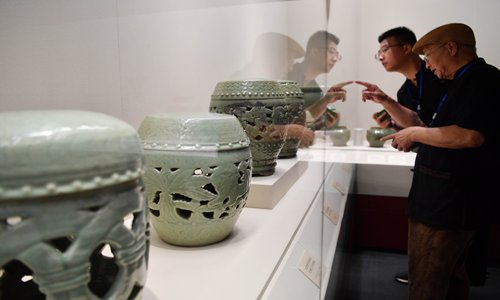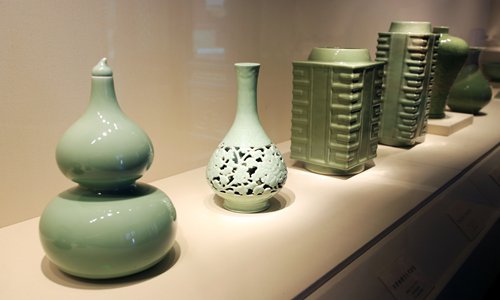‘Longquan Celadon and Globalization’ exhibition kicks off at the Palace Museum

Vistors look at the Longquan celadon wares at the Palace Museum on Monday. Photo: IC

Longquan celadon wares on the exhibition of "Longquan Celadon and Globalization" at the Palace Museum on Monday Photo: IC
The Longquan of the World: Longquan Celadon and Globalization exhibition opens at the Palace Museum in Beijing on Monday. Featuring 833 Longquan celadon items from 42 domestic and international museums and archaeological institutes, it boasts the largest number of Longquan celadon wares ever put on display at the museum.Longquan is a county-level city in East China's Zhejiang Province. There were once around 400 kiln sites in Lonquan, most of which were established during the Song Dynasty (960-1279) or Yuan Dynasty (1279-1368). Many archeological sites throughout China have unearthed Longquan celadon, a testament to their popularity. In fact, thanks to the increasing demand for Longquan celadon around the ancient world, these porcelains can be found in countries such as Vietnam, Indonesia, Thailand, Japan and the UK.
Longquan celadon discovered in ancient shipwrecks and post house sites show how these wares were transported across the vast land and ocean trade routes that made up the Silk Road and the Maritime Silk Road. Not only did Longquan celadon spread abroad, the techniques and styles were also imitated by kilns in countries like Iran, Japan, the UK and Vietnam. For this reason, Longquan celadon has become a symbol of cultural communication and a sign of the early stages of globalization.
The exhibition consists of four sections.
The first section, Longquan Millennium, demonstrates the development process of kilns in the region and reveals the reason why Longquan celadon wares were able to influence the ceramic industry around the world. The second section, National Vessels, shows the role of Longquan celadon wares in the imperial courts.
The third section, Global Spread, displays how Longquan celadon wares were traded and distributed in China and abroad as an important constituent of the global trade system between the 12th and 15th centuries. The last section, Brilliant Harmony, demonstrates how kilns in different areas of China and foreign countries imitated Longquan celadon by learning its patterns, glaze colors and forms.
After the Palace Museum exhibition ends on October 20, it will travel to the Zhejiang Provincial Museum, where it will be held from November 15 to February 16, 2020.